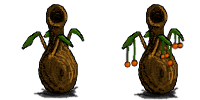Native to Fnarlang 8, the Vangalri were at a bronze age level of development when their planet was conquered by the Empire of 1,000,000 Suns. Having evolved in the total darkness of Fnarlang 8's opaque atmosphere, the Empire put them to work in various occupations where light levels were naturally low, such as mining, insect farming, and geoengineering, as a way to save on lighting. As the nomad armies and breakaway states spread across the galaxy, many Vangalri went with them.
Biology
Vangalri are an omnivorous, egg-laying species evolved to live in total darkness.
Their skin is covered in short fur usually mottled-grey in color. Vangalri blood is copper-based, and has a greenish hue, which shows on the hairless portions of their bodies. Vangalri breathe oxygen and exhale carbon dioxide.
The cleft running down the center of a Vangalri's head is a complex sound-organ used for echo-location and speech. Their cheeks contain a pair of small secondary lungs that provide airflow to the sound-organ.
Their main means of locomotion is slithering on their snake-like hindquarters.
A Vangalri's hands consist of a single finger and a thumb, like a mitten, terminating in broad, blunt claws. Fine manipulation is accomplished with the tentacles growing near their mouths.
Coming from a planet with 1.82g makes Vangalri somewhat stronger and more resilient to acceleration than the average Human.
The hair-like growth around a Vangalri's mouth helps to filter out various life-forms and volcanic ash that fill the air on Fnarlang 8.
Vangalri typically hibernate for about two weeks, during the coldest part of the winter (commonly known as the "frost season"). This seems to be an evolutionary holdover from an earlier epoch in Fnarlang 8's history, when the climate was colder.
Environment
The Vangalri home-world, Fnarlang 8, is a highly volcanic environment with high humidity, and a large amount of microscopic airborne life, leaving the atmosphere opaque to visible wavelengths of light. In the upper atmosphere, photosynthetic microbes form vast living clouds, consuming most of the available light. At lower layers, other microbes live off of volcanic gasses, giving off the oxygen that the Vangalri breathe. Gravity is a bit higher than Earth-normal, at 1.82g. The ground and water are inhabited by plant- and animal-like life. The year on Fnarlang 8 is around 450 Standard days long. The day is about 10 standard hours (not that it makes much difference on a planet with an opaque atmosphere).
Culture
The Vangalri mostly lived at a level of development similar to the bronze age when they were conquered by the E1MS.
There were several large empires, numerous city-states, and a multitude of nomadic tribes on Fnarlang 8 at the time of first contact.
The Vangalri had several well-developed polytheistic, and many animistic religions.
Writing systems were mostly based on stones embedded in clay tablets in a form resembling braille. Reading was done by either touching the tablets, or by echolocation. Spoken language was accomplished with the same sound-organ used for echolocation.
The Vangalri practiced a form of sculpture that was experienced by either tactile or echolocative means. They also had literature, poetry and music. Musical instruments were mostly percussive, with a few string-based as well.
Clothing was made of animal hides and plant-fiber. Typical garments included robes, tunics, gloves (mittens) and belts. A few of the better developed empires also made armor for their soldiers.
Blovonde is a popular desert traditional to Vangalri culture made from small, jellyfish-like creatures that live in the thick atmosphere of their home-world. It is often sold in specialty shops called Blovonderies, and comes in a wide assortment of flavors, and is usually served cold. The texture and consistency of Blovonde falls somewhere between jelly and pudding.










